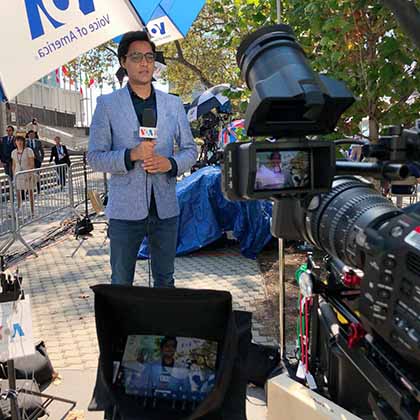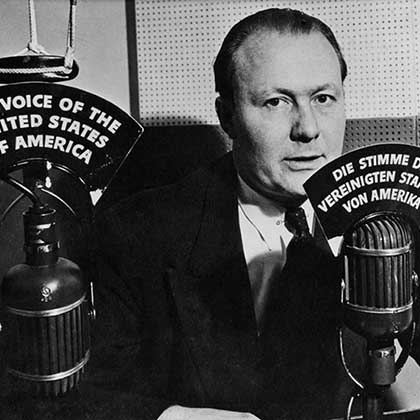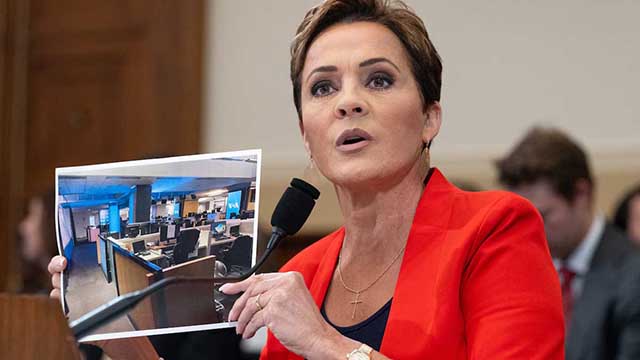Voice of America goes dark
What VOA is and why it matters

Last updated June 9, 1:00 a.m.
Voice of America’s programming has almost completely ceased since President Donald Trump signed an executive order in mid-March calling for its parent agency, the U.S. Agency for Global Media (USAGM), to be reduced to “the maximum extent consistent with applicable law.” Until then, VOA had been broadcasting news around the world since World War II, focusing much of its programming on people who live under repressive governments and cannot get truthful information from their state-run media.
Underlying the mission of VOA, a federally funded U.S. broadcaster, is the belief that America is stronger when people who live in such countries can hear the truth about their governments, the United States and the world. Through its programming, VOA aims to show that a free press — a right enshrined in the U.S. Constitution — delivers not only the truthful voices that people everywhere crave but also demonstrates how free expression itself fuels democracy.
Fight to get back on the air
Since Trump issued his executive order, approximately 500 VOA contractors, working as journalists and support staff, have been fired, and approximately 800 VOA full-time employees have been put on administrative leave. USAGM — effectively led by former journalist-turned-politician Kari Lake, who has been serving as the agency’s special adviser — has ceased almost all VOA programming and has forbidden all but about two dozen journalists from reporting the news.
Employees at VOA have filed two separate lawsuits challenging the legality of the executive order and Lake’s moves to effectively gut the agency. In both cases, federal courts have ruled in favor of the employees, but an appeals court stayed a ruling that would have returned all employees to work while waiting for the appeals court to rule on the merits of the cases.

Where we broadcast
Most Americans have never heard of VOA, and that is by design. VOA’s programming isn’t meant for a U.S. audience because the United States has a robust free press anchored in centuries of practice. Instead, VOA focuses on countering disinformation in places like Russia, going behind China’s Great Firewall, evading the efforts of the Taliban to jam VOA broadcasts and reaching people in more than 100 countries.
While access to the internet and social media have been growing around the world, Reporters Without Borders reported in May that more than half of the world’s population has little to no access to freely reported news because they live in a country where the state of press freedom is described as “very serious.”
VOA seeks to counter that bleak statistic by finding ways around state chokeholds on information and by providing news to people in the languages they speak, one of the few media outlets to do so. VOA’s audience is widespread and diverse: a factory worker listening to radio broadcasts in Mandarin; a farmer watching television programs in Swahili; an office worker reading VOA’s website in Farsi. In total, VOA news sites — including programs on the radio, television, website and social media — broadcast in 49 languages.
By the numbers
VOA has an audience of more than 361 million people each week, as measured by nationally representative surveys in target markets. Research also finds that 86% of VOA users say they consider the information they receive from VOA to be very or somewhat trustworthy, and 76% say that the network’s broadcasts help them to form opinions on important issues, according to USAGM’s 2024 Agency Performance Report.
In a typical week, VOA would broadcast 2,391 hours of content, with about 60% of that for radio and 40% for video. However, by the end of May 2025, with only a handful of journalists working, VOA produced almost no content, and the little it did was in just four languages: Farsi, Mandarin, Dari and Pashto. The output consisted of a few web articles, one or two videos, and a handful of social media posts per day, plus a short daily newscast in only two languages: Dari and Pashto.

VOA journalist Robert Bauer, 1942
Beginnings
By the end of the 1930s, the United States was the only world power without a government-sponsored international radio service. Other nations that were regularly broadcasting beyond their borders included the Soviet Union, Italy, Britain, France, Germany and Japan. The outbreak of World War II prompted the U.S. to begin creating the infrastructure for a federally funded broadcaster. On February 1, 1942, VOA aired its first broadcast in German, seeking to reach those living under Nazi control.
“Daily at this time, we shall speak to you about America and the war. The news may be good or bad. We shall tell you the truth,” announcer William Harlan Hale said.
VOA’s programming is widely credited with playing a role in the collapse of the Soviet Union. “Among the forces that tore holes in the Iron Curtain was the steady bombardment by the Voice of America, Radio Free Europe and Radio Liberty, and the BBC,” said Strobe Talbott, former U.S. deputy secretary of state during the Clinton administration.
In recent decades, VOA has shone the truth in its coverage of the war on terrorism, the Arab spring, the coronavirus pandemic and Russia’s war in Ukraine.
Pledge to tell the truth
From the beginning, VOA has pledged to tell the truth. As John Houseman, VOA’s first director, said later, “In reality, we had little choice. Inevitably the news that the Voice of America would carry to the world in the first half of 1942 was almost all bad. As Japanese invasions followed one another with sickening regularity and the Nazi armies moved ever deeper into Russia and the Near East, we would have to report our reverses without weaseling. Only thus could we establish a reputation for honesty which we hoped would pay off on that distant but inevitable day when we would start reporting our own invasions and victories.”
This ethos was further developed when VOA adopted its charter in 1960, which was codified into law by Congress in 1976. Its first principle: “VOA will serve as a consistently reliable and authoritative source of news. VOA news will be accurate, objective, and comprehensive.”
Timeline of the shutdown
December 12
Lake picked to lead VOA

President-elect Donald Trump says he intends to appoint Kari Lake, a politician and former Arizona journalist, to lead the international, government-funded broadcaster Voice of America.
January 20
Trump's inauguration
Donald Trump is sworn into office as the 47th president.
Late January
Trump fires advisory board
President Donald Trump fires all members of the bipartisan International Broadcasting Advisory Board, which advises the head of VOA's parent agency, the U.S. Agency for Global Media (USAGM). By law, a majority of the board must approve the hiring and firing of network heads, including the VOA director.
February 9
Musk calls for VOA's closure

Elon Musk, then-head of the Department of Government Efficiency (DOGE), posts on X that VOA and its sister agency, Radio Free Europe, should be shut down. Read the post.
February 27
USAGM announces Lake as senior adviser
USAGM says Kari Lake will join the agency as a senior adviser. She is sworn into her position four days later.
Early March
DOGE in the building
DOGE workers enter VOA offices in Washington.
March 12
VOA White House bureau chief rebuked
During a press conference in the Oval Office, VOA White House Bureau Chief Patsy Widakuswara asks Irish Prime Minister Michael Martin, "What about the president's plans to expel Palestinians out of Gaza? Are you discussing that with him and giving him your opinion?" President Donald Trump responds, "Nobody is expelling any Palestinians" and asks Widakuswara, "Who are you with?" When she replies, "I'm with Voice of America, sir," Trump says, "Oh, no wonder." Watch the Oval Office exchange.
March 14
Trump signs executive order

President Donald Trump signs an executive order calling for the elimination of the “non-statutory components and functions” at USAGM, reducing the agency “to the maximum extent consistent with applicable law.” Read the order.
March 15
VOA programming goes dark
USAGM, effectively led by Kari Lake, ceases all VOA programming, forbids journalists from reporting the news, and places more than 1,300 workers on administrative leave.
March 15
Lake cancels lease for new VOA building
Kari Lake terminates a 15-year lease that had been signed during the Biden administration to move VOA’s headquarters to a new D.C. location. In a press release, Lake calls the lease an example of “obscene over-spending.” The previous administration argued the relocation would save VOA more than $150 million over the course of the lease.
Read the original September 2024 USAGM announement.
Read former USAGM CEO Amanda Bennett's op-ed challenging Lake's assertions.
March 16
Contractors fired
Nearly 600 VOA journalists working as independent personal services contractors (PSCs) are given notices of termination.
March 21
First lawsuit filed

Seven VOA employees, including Patsy Widakuswara, along with unions representing federal employees, and Reporters Without Borders file a lawsuit challenging the effective closure of VOA and the administration’s plans to fire all of its journalists. Read the lawsuit.
Read RSF’s letter of support (PDF).
March 25
Former directors urge Congress to protect VOA
Former VOA directors nominated across party lines send a letter to Congress urging them to save the broadcaster. Nine of the 10 then-living former directors sign the letter, saying President Donald Trump’s efforts to end VOA “amount to a gift to China, Iran, Russia and other oppressive regimes around the world." Read the letter (PDF).
March 26
Second lawsuit filed

VOA Director Michael Abramowitz, who has also been placed on leave, files a second lawsuit against VOA’s shuttering, along with three other plaintiffs. Read the lawsuit (PDF).
March 28
Judge grants temporary restraining order

The U.S. District Court for the Southern District of New York rules in favor of VOA employees and grants a temporary restraining order prohibiting the administration from carrying out its planned layoffs. Judge Paul Oetken says in his ruling that USAGM failed to “provide a single sentence of explanation for the colossal changes that have occurred at USAGM since March 15, 2025.” Read the order (PDF).
March 29
Contractors are reinstated
After the issuance of the TRO, VOA contractors are informed by USAGM that their contracts were put on hold "until further notice," and they will remain on administrative leave with regular pay and benefits.
April 16
State Department cables say the shuttering of VOA hurts US interests
In a declaration to federal court, American Foreign Service Association President Thomas Yazdgerdi highlights cables sent by U.S. diplomats around the world arguing that the closure of U.S. international media will likely help foreign governments such as Russia and China to undermine U.S. policy.
Read his declaration.
Read the plaintiffs’ full court filing for a preliminary injunction (PDF).
April 17
Court hears arguments on preliminary injunction
The U.S. District Court for the District of Columbia hears oral arguments on the two VOA cases to consider a preliminary injunction.
April 22
Judge orders VOA employees back to work

Judge Royce Lamberth rules in favor of VOA employees, ordering USAGM to return staff and contractors to their work status prior to March 14 and to “restore VOA programming such that USAGM fulfills its statutory mandate that VOA ‘serve as a consistently reliable and authoritative source of news.’”
Lamberth calls the administration’s decision to dismantle VOA “arbitrary and capricious” and writes, “Not only is there an absence of 'reasoned analysis' from the defendants; there is an absence of any analysis whatsoever.”
Read the full memorandum opinion (PDF).
Read the order (PDF).
April 25
USAGM appeals return-to-work ruling
USAGM appeals Judge Royce Lamberth's order that VOA employees and contractors be returned to work. Lamberth denies the appeal, which then moves to the U.S. Court of Appeals for the District of Columbia Circuit. Read the ruling (PDF).
May 3
Appeals court stays part of ruling
A three-judge panel at the U.S. Court of Appeals for the District of Columbia Circuit issues a stay on the reinstatement of VOA employees, ruling 2-1 that the government does not need to bring employees back to work while the court decides the merits of the case. The appeals court notes the government did not challenge the aspect of Judge Royce Lamberth's ruling requiring it to restore VOA’s "statutorily required programming levels." Read the ruling (PDF).
May 6
Handful of workers return
USAGM issues a return-to-work order to a couple dozen full-time employees to produce minimal content in only four of the 49 languages: Farsi, Mandarin, Dari and Pashto. The output consists of a few web articles, one or two videos, and a handful of social media posts per day, plus a daily five-minute newscast in only two languages: Dari and Pashto.
May 15
Contractors are fired again
USAGM reissues termination notices for nearly 600 contractors. The termination dates vary, effective on May 23, May 30 and June 5.
May 22
Appeals court declines intervention
The full U.S. Court of Appeals for the District of Columbia Circuit declines to intervene in the case, at least for now. Read the order (PDF).
May 27
Request for appeals court to act quickly
Plaintiffs of Widakuswara v. Lake submit a motion to the U.S. Court of Appeals for the District of Columbia Circuit to expedite the appeals process, citing contractor terminations and concern about employee firings. Read the motion (PDF).
May 28
Plaintiffs say USAGM is not following judge's order
Abramowitz v. Lake plaintiffs ask the court to make USAGM explain why it hasn't followed Judge Royce Lamberth's order to restore VOA. Read the motion (PDF).
May 31
Plaintiffs call for US district court to hold new hearing
Widakuswara v. Lake plaintiffs argue that USAGM is still trying to shut down VOA in violation of Judge Royce Lamberth's order and ask the court to hold a hearing quickly. Read the motion (PDF).
May 31
Co-plaintiff Kate Neeper provides a declaration in support of the request, chronicling the substantial decrease in VOA output. Read the declaration (PDF).
June 2
USAGM asks for pause in lower court proceedings
USAGM asks Judge Royce Lamberth to pause all ongoing legal proceedings in the two cases (Widakuswara v. Lake and Abramowitz v. Lake) until the appeals court makes its ruling. Read the motion (PDF).
June 3
Lake informs Congress of large staff cuts
As first reported by the Washington Post, Kari Lake sends a letter to Congress, saying she plans to cut most of the 800 remaining staff members at VOA. Her plan is to keep only 17 journalists and broadcast technicians, down from more than 1,300 employees who worked at the broadcaster at the start of March. Read the letter (PDF).
June 4
USAGM says it can decide content amount
USAGM insists it has broad discretion to run VOA and that there is no rule requiring a specific staff size or content output. Read the motion (PDF).
June 13
USAGM recalls Persian service amid Iran-Israel conflict
USAGM issues a return-to-work order for about 75 full-time employees who work in the Persian service or as broadcast technicians to cover the growing conflict between Israel and Iran.
June 13
USAGM argues it is meeting the statutory minimum
USAGM files papers in U.S. district court detailing why it believes VOA is meeting the minimum programming required by Congressional statute. Read the motion (PDF).
June 17
USAGM asks for a lower court stay to pause legal proceedings
USAGM files papers in U.S. district court asking Judge Royce Lamberth not to rule on motions related to the case, arguing that the appeals court can make all decisions when it hears the case on its merits. Read the motion (PDF).
June 20
USAGM begins mass layoffs
USAGM launches mass layoffs of VOA and USAGM staff, including some members of the Persian service that it called back to work the prior week to cover Israel’s war with Iran. Employees last day on the payroll will be September 1, Labor Day.
Read the USAGM announcement.
Read the plaintiffs’ response.
June 23
Judge holds hearing on cuts to VOA
At the hearing, Judge Royce Lamberth asks a Justice Department attorney why the government did not inform him of recent layoff notices sent to VOA employees and asks the government for more information about whether it is complying with his order to preserve VOA. “What would be the purpose of Voice of America if there was no voice?” Lamberth asks. Watch the plaintiffs’ press conference.

June 25
Lake testifies to House committee
Kari Lake attacks VOA during testimony to the House Committee on Foreign Affairs.
Read the plaintiffs’ response.
Read an annotated fact check of Lake’s opening remarks.
June 25
USAGM argues court cannot force it to undo layoffs
USAGM files papers in U.S. district court arguing the executive branch has the legal right to decide how to manage its agencies, including reducing staff and funding. Read the government's brief (PDF).
June 27
USAGM rescinds layoffs due to errors
USAGM reverses the layoffs it issued only one week prior, but says it will carry out another round of layoffs in the near future. Union representatives at VOA say the reversal is due to the agency’s violations of law and contract in the way it carried out the layoffs. Read the email.
June 27
USAGM says it is complying to restore VOA programming
In papers filed in U.S. district court, USAGM argues that it is complying with Judge Royce Lamberth’s order to restore VOA programming so that it fulfills the statutory minimum. The agency also argues it should not be held in contempt as the court has threatened, asserting it has been acting in good faith to carry out the court’s orders. Read the government’s filing (PDF).
July 2
Plaintiffs argue USAGM is ignoring court order
Plaintiffs in both VOA cases file papers in U.S. district court arguing that USAGM under Kari Lake’s leadership still does not have a plan for the agency. They say USAGM is ignoring Judge Royce Lamberth’s order for the agency to fulfill its statutory obligations.
Read the plaintiff’s filing in Widakuswara v. Lake (PDF).
Read the plaintiff’s filing in Abramowitz v. Lake (PDF).
July 8
Court orders government to provide plan for VOA
Judge Royce Lamberth gives the government 10 days to give a clear plan for its actions at VOA. The judge notes contradictions in what the government says it is doing at VOA and the reality of the situation. Read the order (PDF).
July 14
House committee begins budget process for USAGM
A House Appropriations subcommittee proposes spending $681 million for international media in fiscal year 2026. Read the committee bill (PDF).
July 15
Plaintiffs file written brief with appeals court
The plaintiffs in the two cases against USAGM (Widakuswara v. Lake and Abramowitz v. Lake) file their briefs on the merits of the case at the U.S. Court of Appeals for the District of Columbia Circuit, arguing that the government acted unlawfully in attempting to dismantle USAGM without legal or procedural justification. Oral arguments are scheduled to be heard by the court on September 22. Read the brief (PDF).
July 18
Lake defends VOA’s minimal broadcasting
The government responds to Judge Royce Lamberth’s order to give a further accounting of the situation at VOA, with Kari Lake writing in a declaration that 72 employees are currently working at VOA to produce a small amount of content in four languages (Mandarin, Dari, Farsi and Pashto). The government continues to offer no explanation as to how they came to determine that these languages represent the statutory minimum. Read the government’s response (PDF).
July 18
Government files motion to dismiss lawsuits
USAGM asks the court to dismiss the lawsuits against it, arguing that the court lacks jurisdiction and that the agency has full discretion to run its day-to-day operations as it sees fit. Read the motion (PDF).
July 22
Former U.S. military officials and diplomats sign court brief supporting VOA
Fifty-four former U.S. officials, including 25 former senior military officials, sign an amicus brief in support of VOA and its mission. The brief says that these officials are “united in their view that VOA has served and advanced American foreign policy goals, supported the spread of democracy, and provided a model of freedom and truth to people around the world.”
Read the full brief (PDF).
Explore all of the amicus briefs.
July 23
VOA director files court motion challenging his removal from role
VOA Director Michael Abramowitz, who previously filed a lawsuit against VOA’s shuttering, asks the U.S. district court to prevent USAGM’s attempts to remove him from his role. The motion for an injunction accuses USAGM of acting without cause and against the law.
Read the motion (PDF).
Read a supporting declaration by Abramowitz (PDF).
July 30
VOA wins lower court motion
Judge Royce Lamberth finds the government has failed provide the court with accurate information about how it is spending Congressionally-appropriated funding for VOA. He further finds that the government has failed to fully explain how it intends to comply with the court’s injunction for VOA to meet its statutory obligations. Lamberth gives USAGM until August 13 to provide a detailed plan.
Read the order.
August 4
VOA director receives termination notice
Lawyers for VOA Director Michael Abramowitz inform the court that USAGM sent a letter firing Abramowitz after he refused to accept reassignment to a lower post. The letter said Abramowitz would be terminated on August 31. Lawyers for the VOA director urge the court to quickly rule on their previously filed motion for an injunction. Read the latest court filing.
August 13
USAGM offers court no new details about plans for VOA
In response to a court order directing USAGM to lay out its plans for VOA to meet its statutory obligations, the government repeated its belief that VOA’s current minimal programming in four languages fulfills that duty. Kari Lake said in a declaration that she intends to help President Donald Trump to fulfill his wish to close USAGM “within the bounds of current and future federal law.” Read Lake’s declaration.
Read the defendants' response and supporting documents in exhibit 1.
August 22
Plaintiffs urge court to hold Lake and USAGM in contempt
Ahead of a U.S. district court hearing, the plaintiffs in the two cases against USAGM (Widakuswara v. Lake and Abramowitz v. Lake) call on the court to hold the defendants in contempt. “At every juncture of the show-cause process, Defendants have obfuscated and resisted explaining how they are complying” with the court’s order to restore VOA programming to meet statutory obligations. Read the court filing.
August 25
Court orders Lake be deposed over VOA dismantling
Judge Royce Lamberth said Kari Lake is “on the verge of contempt” and “clearly hasn’t complied with my order” to restore VOA programming to fulfill its statutory obligations. At a U.S. district court hearing, he ruled in favor of a plaintiff request to depose three senior USAGM officials, including Lake, who is effectively heading the agency, but stopped short of holding Lake in contempt. Read the court order.
August 26
USAGM takes steps toward issuing new layoff notices
In a court filing, the agency reveals that it has sent retention registers to federal unions ahead of a new, impending round of employee layoffs. The agency previously announced mass layoffs of VOA and USAGM staff on June 20, but rescinded the notices a week later due to administrative errors. Read the court notice.
August 28
VOA director wins court ruling prohibiting his firing
Judge Royce Lamberth rules that USAGM, and its effective head, Kari Lake, are prohibited from firing VOA Director Michael Abramowitz without approval from a majority of the International Broadcasting Advisory Board as is required by law. President Donald Trump fired the advisory board shortly after taking office. USAGM had ordered Abramowitz to step down as VOA director and take an unrelated job in North Carolina. When he declined, the agency sent him notice of his firing. Read the order.
August 28
Trump issues order ending collective bargaining at USAGM
By executive order, President Donald Trump adds several more agencies, including USAGM, to an already long list of federal entities that he is mandating end collective bargaining agreements. Trump says the move is to “enhance the national security of the United States,” but many of the listed agencies perform no obvious national security functions, including USAGM, the National Weather Service and the Department of Health and Human Services. Unions representing federal workers argue the order is a form of retaliation against their lawsuits challenging the administration’s actions. Read the executive order.
August 29
USAGM begins new round of mass layoffs
Kari Lake announces the agency is eliminating 532 positions at VOA and USAGM, nearly all remaining staff save for a skeleton crew. Employees' last day on the payroll will be September 30. The agency previously announced mass layoffs of staff employees in June, but rescinded the notices a week later due to administrative errors. Beginning in late May, the agency fired nearly 600 contract workers.
September 8
Plaintiffs file motion to pause mass layoffs
Lawyers for the plaintiffs request Judge Royce Lamberth to put on hold the mass firings by Kari Lake, arguing that they hamper the court’s ability to enforce its injunction that USAGM carry out its statutory obligations. "These large-scale RIFs further threaten" the effort by the court to ensure USAGM is following the law, lawyers for the plaintiffs wrote. Read the motion.
September 9
Lake is deposed by plaintiffs' attorneys
Kari Lake is the first of three USAGM officials to be deposed by attorneys for the plaintiffs. The court agreed with a plaintiff request for a judge or court official to be available by phone if questions arise during the proceedings.
September 10
Judge rules transcript of Lake’s deposition can be made public
Judge Royce Lamberth rules that the transcripts of Kari Lake and two other USAGM officials who were deposed over their efforts to effectively shut down the agency can be released to the public. An initial order gives both sides the opportunity to request redactions, but a later order clarifies that neither side requested redactions to Lake's transcript.
September 19
Unions sue over Trump order ending collective bargaining
Two unions representing federal workers — the American Federation of Government Employees and the American Federation of State, County and Municipal Employees — sue President Donald Trump over his August executive order stripping employees at USAGM and VOA of their collective bargaining rights. The unions argue that the order is meant to punish them for challenging the shutdown of VOA in court and is “part of a pattern of retaliation by this administration against labor organizations that speak out and litigate against its policies.” Read the lawsuit.
September 22
Appeals court hears VOA cases
The U.S. Court of Appeals for the District of Columbia Circuit hears oral arguments on whether Judge Royce Lamberth’s April preliminary injunction to restore jobs of employees and contractors should be upheld.
Listen to audio of the hearing.
September 22
Lake deposition released to public
Judge Royce Lamberth releases a transcript of Kari Lake's deposition. Lamberth ordered Lake and two other senior USAGM officials be deposed by the plaintiffs' lawyers over their actions to shut down VOA. Read the deposition.
September 24
Plaintiffs urge court to pause mass layoffs in new filing
Lawyers for the plaintiffs request Judge Royce Lamberth to put on hold the mass firings by Kari Lake, arguing the layoffs would make it impossible for USAGM to follow his injunction to restore VOA programming to fulfill its statutory mandate. The lawyers say the recent court-ordered deposition of Lake and other senior USAGM officials show the agency has failed to comply with the injunction and “have no plan to do in the future.” Read the filing.
September 29
Court hears arguments to pause mass layoffs
Judge Royce Lamberth holds a hearing on a plaintiffs’ motion to pause the mass layoffs of employees at VOA and USAGM. The employees' last day on the payroll is set for September 30.
September 29
Court pauses mass layoffs at VOA
Judge Royce Lamberth rules the administration must temporarily suspend its planned layoffs of more than 500 employees at VOA and USAGM. He said the defendants, including Kari Lake, have engaged in "obfuscation” about the agency's layoff plans and whether or not the layoffs accord with the court’s preliminary injunction to restore VOA programming to fulfill its statutory mandate. Read the order.
September 30
USAGM pauses mass layoffs following court order
An email from the agency’s HR department informs employees that the reduction in force is suspended. “All RIF proceedings covered by the Court’s September 29 Order are currently on hold,” it said.
October 1
VOA stops all broadcasting after government shutdown
USAGM furloughs all VOA journalists in response to the government shutdown and ceases the few remaining VOA programs that were being broadcast. During previous shutdowns, VOA always remained on the air due to its role in foreign relations essential for U.S. national security.
October 6
Appeals court rules in favor of VOA director
A three-judge panel at the U.S. Court of Appeals for the District of Columbia Circuit declines to stay the blocked firing of VOA Director Michael Abramowitz. The ruling means Abramowitz will remain on administrative leave and will not be fired while the appeals process plays out. Read the ruling.
November 13
With end of government shutdown, VOA resumes limited broadcasts
After furloughing all VOA journalists for more than a month during the government shutdown, USAGM brings back a handful of employees to produce limited programming again in four languages — Mandarin, Dari, Pashto and Persian. The resumption of a few hours of broadcasts per week remains a stark contrast to VOA’s once-vibrant, round-the-clock coverage in 49 languages, totaling nearly 2,400 hours of weekly content. The majority of VOA full-time employees remain on administrative leave.
